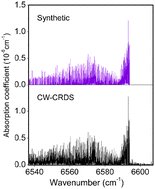Weak vibrational bands of 16O3 could be detected in the 5850–7030 cm−1 spectral region by CW-cavity ring down spectroscopy using a set of fibered DFB diode lasers. As a result of the high sensitivity (noise equivalent absorption αmin ∼ 3 × 10−10 cm−1), bands reaching a total of 16 upper vibrational states have been previously reported in selected spectral regions. In the present report, the analysis of the whole investigated region is completed by new recordings in three spectral regions which have allowed: (i) a refined analysis of the ν1 + 3ν2 + 3ν3 band from new spectra in the 5850–5900 cm−1 region; (ii) an important extension of the assignments of the 2ν1+5ν3 and 4ν1 + 2ν2 + ν3 bands in the 6500–6600 cm−1 region, previously recorded by frequency modulation diode laser spectroscopy. The rovibrational assignments of the weak 4ν1 + 2ν2 + ν3 band were fully confirmed by the new observation of the 4ν1 + 2ν2 + ν3− ν2 hot band near 5866.9 cm−1 reaching the same upper state; (iii) the observation and modelling of three A-type bands at 6895.51, 6981.87 and 6990.07 cm−1 corresponding to the highest excited vibrational bands of ozone detected so far at high resolution. The upper vibrational states were assigned by comparison of their energy values with calculated values obtained from the ground state potential energy surface of 16O3. The vibrational mixing and consequently the ambiguities in the vibrational labelling are discussed. For each band or set of interacting bands, the spectroscopic parameters were determined from a fit of the corresponding line positions in the frame of the effective Hamiltonian (EH) model. A set of selected absolute line intensities was measured and used to derive the parameters of the effective transition moment operator. The exhaustive review of the previous observations gathered with the present results is presented and discussed. It leads to a total number of 3863 energy levels belonging to 21 vibrational states and corresponding to 7315 transitions. In the considered spectral region corresponding to up to 82% of the dissociation energy, the increasing importance of the “dark” states is illustrated by the occurrence of frequent rovibrational perturbations and the observation of many weak lines still unassigned.

You have access to this article
 Please wait while we load your content...
Something went wrong. Try again?
Please wait while we load your content...
Something went wrong. Try again?


 Please wait while we load your content...
Please wait while we load your content...